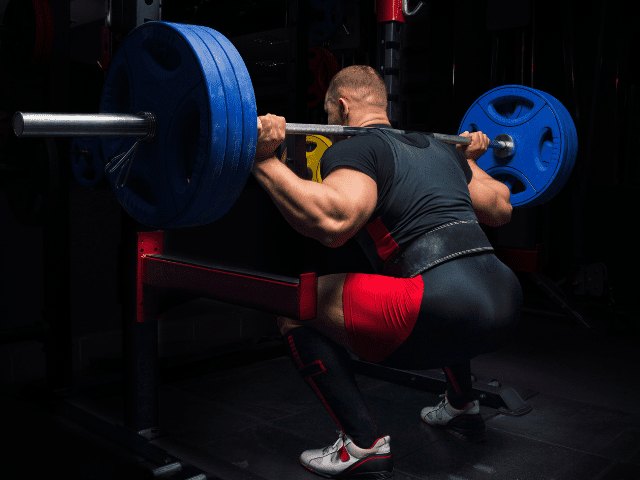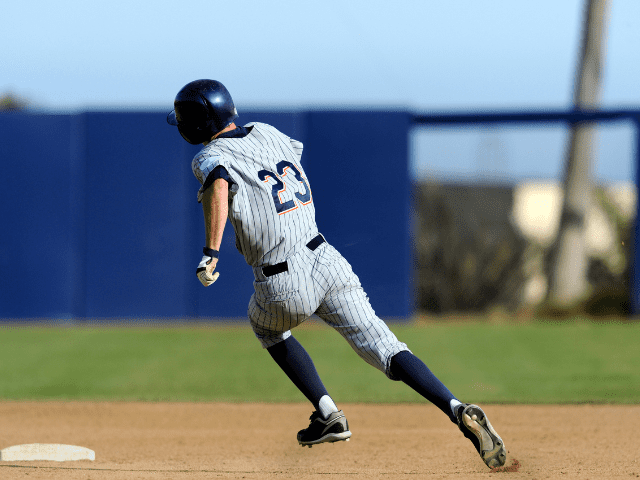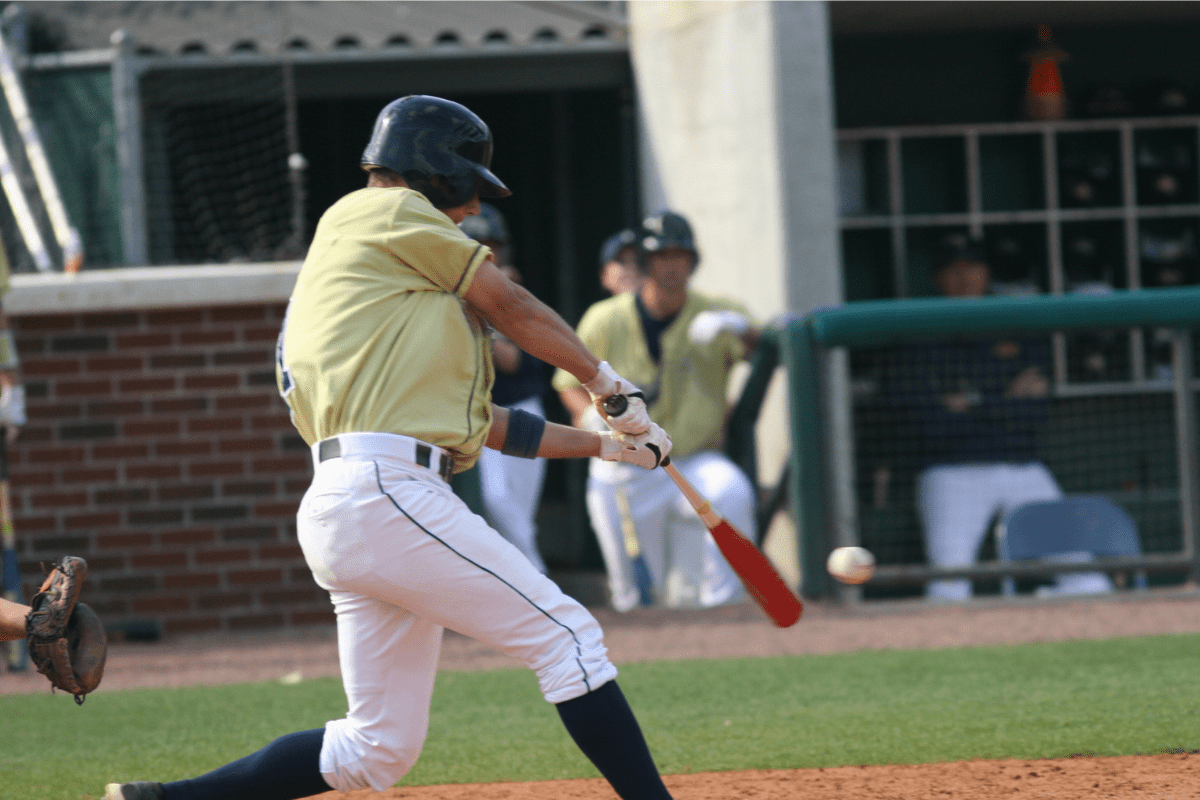Should Baseball Players Squat? (5 Reasons Why)
Lower half strength and power help baseball players run faster, hit farther, throw harder, and stay resilient to injury. One of the most efficient ways to gain lower body strength is squatting. Squatting has been used for over a century to gain strength and power for sport.
In this article, I am going to go over the 5 reasons baseball players should squat, 5 squatting variations for baseball, and more!
5 Reasons Baseball Players Should Squat
1. Increased Lower Body Strength

Squatting to increase lower body strength will help transfer to increased throwing and hitting power.
Focus on moving the bar fast and driving those hips out of the hole of the squat. The knee and hip extension we see in the squat will help with sport-specific movements like hitting, throwing and sprinting.
2. Posterior Chain Development
Squatting is also great for developing the posterior chain.
The posterior chain is the group of muscles on the back side of the body (Glutes, hamstrings, erectors, lats, upper back, calf muscles). The posterior chain is associated with helping decrease the likelihood of injury and increased explosive athletic performance.
A properly performed squat will engage all of these muscles in a healthy range of motion.
3. Increased Sprint Speed

Sprint speeds have also been improved with squatting. Increased force production in the lower half has shown a negative correlation with sprint times (Squat strength goes up and sprint times come down).
A program that implements sprinting and squatting in conjunction with each other has been shown to be superior to a program with one and not the other.
One important note here is that I always trained athletes to do their sprint work (technique work, starts, acceleration, and top-end work) prior to heavy lifting. This allowed the athlete to have the freshest legs possible for the most explosive work at the beginning of the session.
I found athletes benefited most from sprints, squats, and accessory work in that order.
For example:
Field Work
- Dynamic Warm Up
- Sprinting Technique Drills
- Plyometrics
- Acceleration Drills
- Build Ups
Weight Room
- Clean Pulls
- Med Ball Throws
- Back Squat
- Goblet Reverse Lunge
- Glute Ham Raise
- Core Work
4. Upper Body and Core Stability
Squatting variations also require the upper body and core to stabilize dynamically. This is one of the greatest benefits of compound movements (movements that utilize more than one muscle group at a time).
In baseball, our upper body and cores are isometric stabilizers in many positions.
Right before contact with swinging, our cores are bracing isometrically. As we move into external rotation in our throwing windups, our shoulders, upper backs, and lats are eccentrically and isometrically contracting before moving into delivery.
The squat is a great compound movement that trains the entire body as one unit.
5. Flexibility and Mobility
One of the overlooked benefits of squatting is the flexibility and mobility it can provide athletes.
In order to gain these benefits, squats need to be performed with perfect technique. Properly performed compound exercises have been shown to improve passive flexibility and dynamic mobility. Tissue pliability and strength are both improved with squatting properly.
Lifters often experience soreness and believe they are becoming stiff due to resistance training protocols. Athletes need to focus on perfecting their technique and focus on bar speed and not the load on the bar. Improving eating and sleeping habits will also help lifters recover from feeling sore.
Focusing on these things will help athletes improve their performance, flexibility, and mobility, and bounce back ready for heavy practice and competition loads.
5 Squatting Variations For Baseball
1. Back Squat
The Back Squat is one of the most popular squatting variations for many sports. This variation is fantastic for baseball because of the similar body positions we see on the field. Hip hinge, knee bend, ankle mobility, upper body, and core stability, all of these are extremely important for baseball performance.
The back squat is also a great option for implementing accommodating resistance variations. Back squatting can be easily done to a box, chains, bands, eccentric holds, and pauses are all variations that can be easily implemented in lifting programs.
2. Front Squat

The front squat is a fantastic option for baseball players. The front squat requires the lifter to hold the bar in a front rack position. This trains the shoulders, upper back, and core to stabilize even more as you perform the squat.
This variation is also specific to the clean. If a baseball player chooses to perform clean variations, the front squat will help train the specific squat pattern needed to drive the bar out of the hole of a clean.
I do recommend cleans for position players in the off-season. Position players with a clean history of injury with cleans, good wrist and shoulder flexibility, would benefit greatly from clean variations.
3. Safety Bar Squat
One of my favorite squatting variations for pitchers and high shoulder load players, the safety bar squat is a fantastic option for baseball players. The safety bar allows players to train their lower bodies without placing any extra load on the upper body as they perform the squat.
You still have to stabilize the core and perform the squat, but the pads on the safety bar and handles in front allow players to train the lower body without taxing the upper half as much.
4. Barbell Split Squat
Single leg training is important for most sports and especially baseball. Squatting does not just have to be bilateral.
A great unilateral, compound squatting movement for baseball, is the barbell split squat. This is a great exercise for single leg strength, upper body and core stability, and ankle and hip mobility. This is also a great sport-specific movement for sprinting, hitting, and throwing.
5. Rear Foot Elevated Split Squat
Another fantastic unilateral squatting variation for baseball, is the rear foot elevated split squat. I like this movement especially because of the variability in how you load it. You can use a barbell, two dumbbells at your side, one dumbbell in the goblet position, or even a weight vest.
Final Thoughts
I think squatting is one of the best exercises for baseball performance. We see athletes taking time off their 60-yard sprints, hitting more home runs, and throwing harder when the lower body is strengthened.
It is important to:
- Train with a qualified coach and/or materials
- Focus on technique and speed
- Progressively overload (Never sacrifice technique for more weight)

Need a Training Program?
Get a program written by a college baseball Strength and Conditioning Coach.
Our Baseball Strength and Conditioning Program is an 8 Week, 4 Day-per-week program that includes Warm-ups, Speed & Agility, Conditioning and Strength Training.
More Links and Info
Looking to take your game to the next level? Check out some of my other baseball articles:

